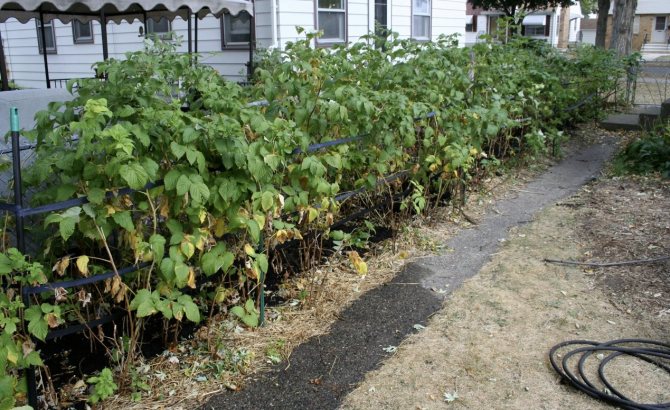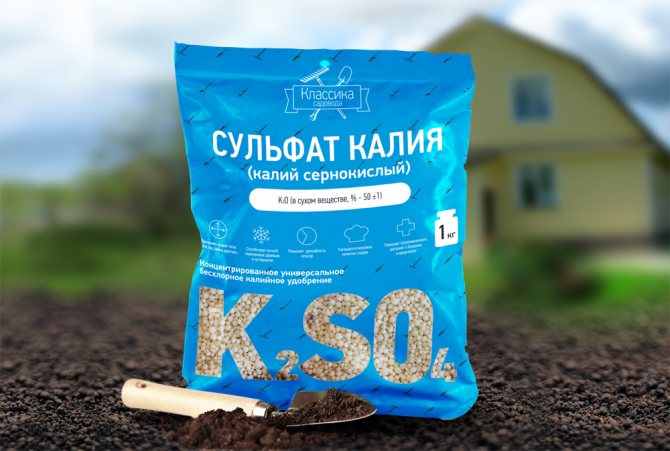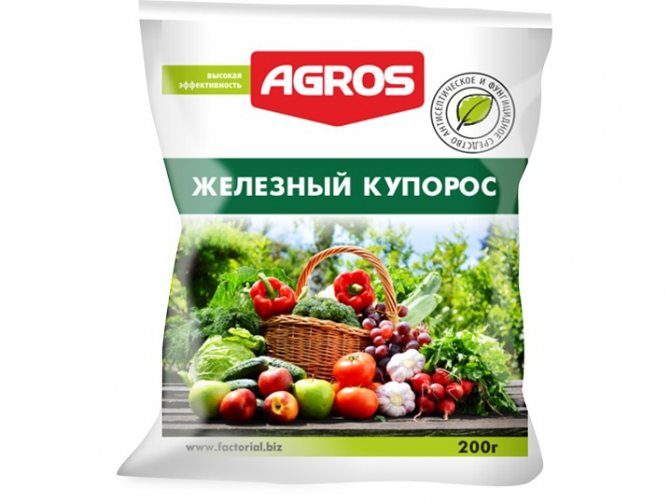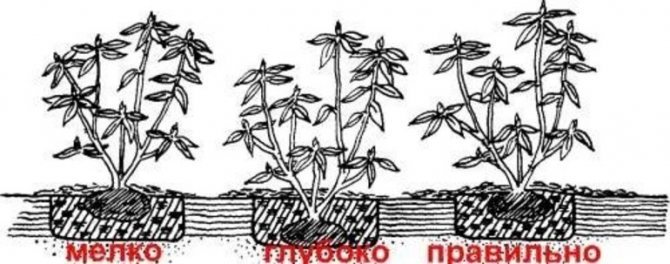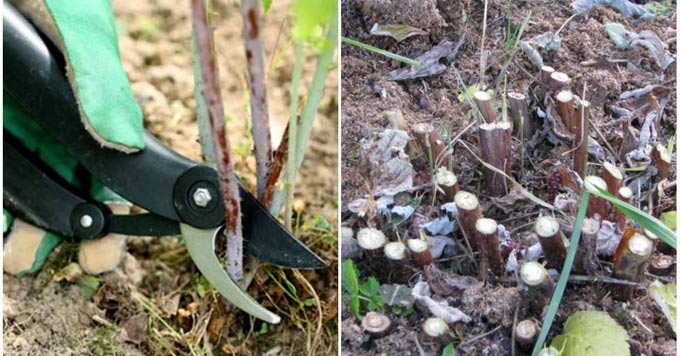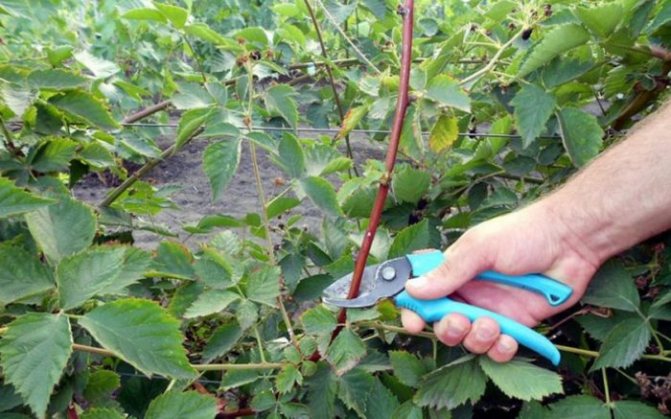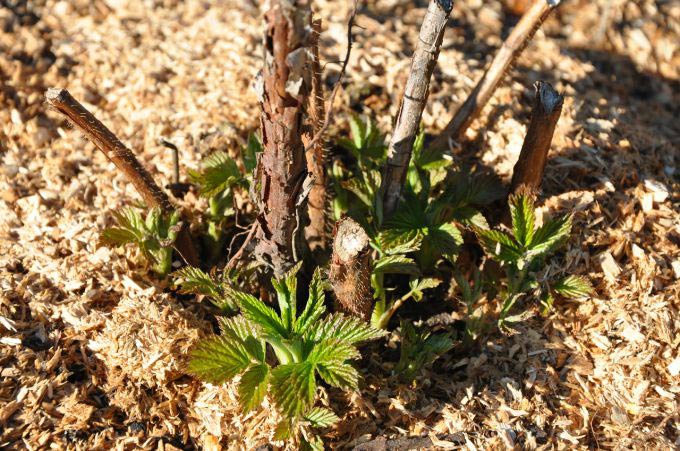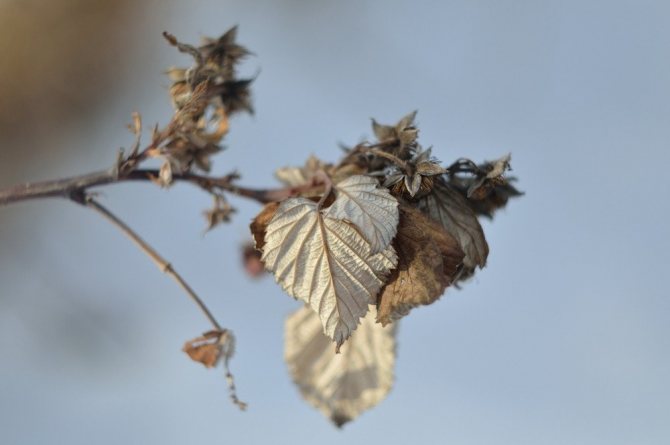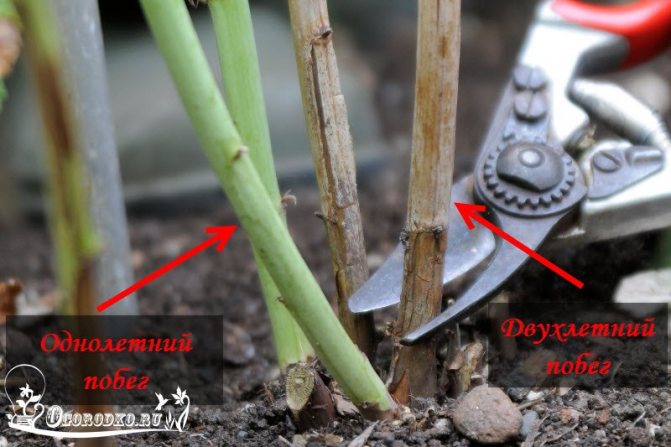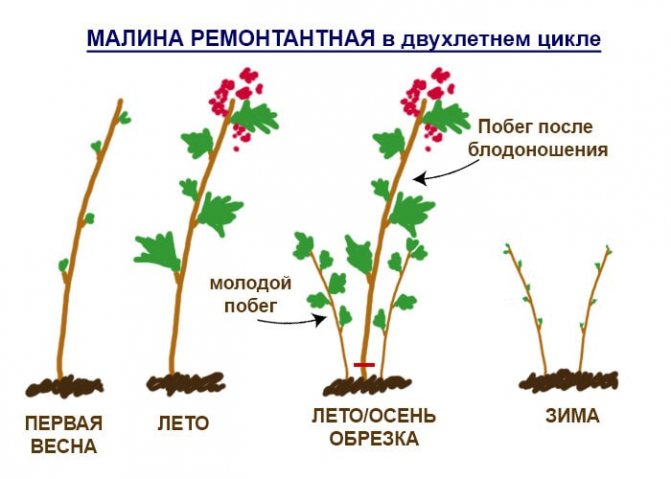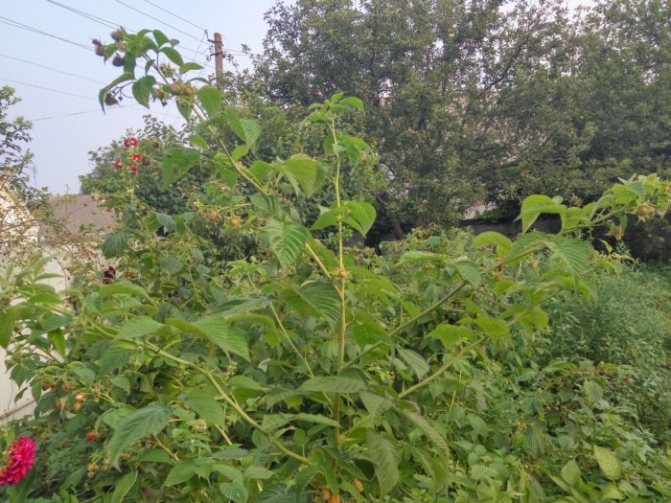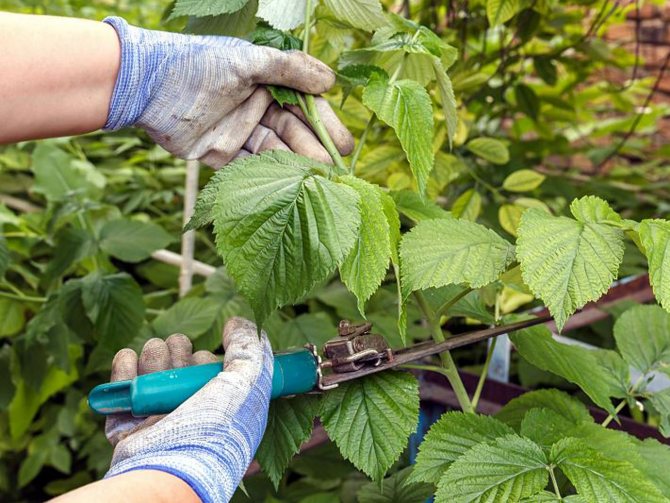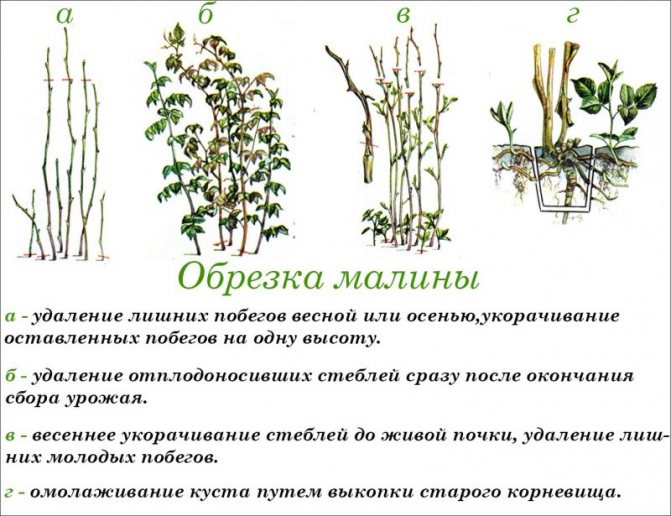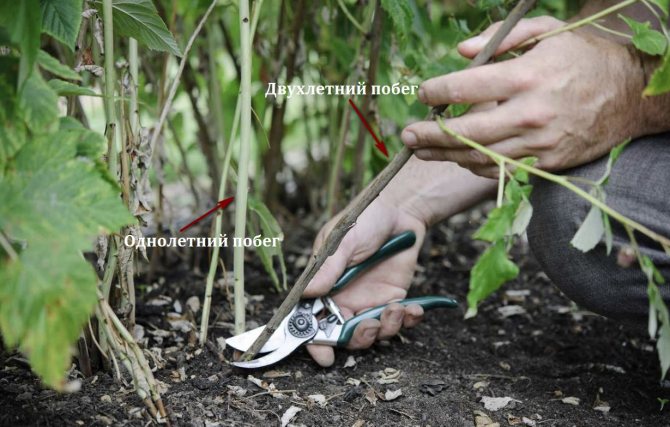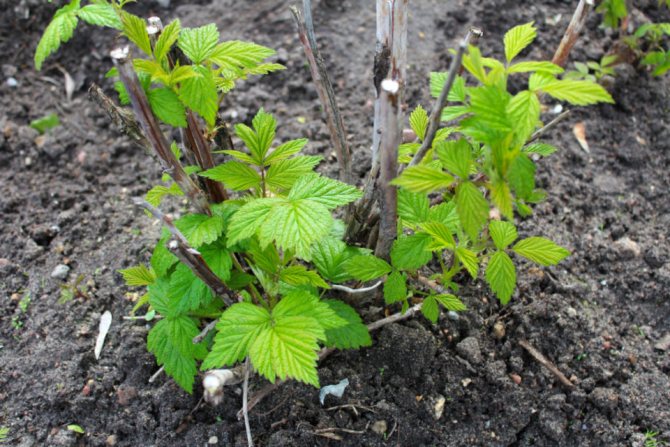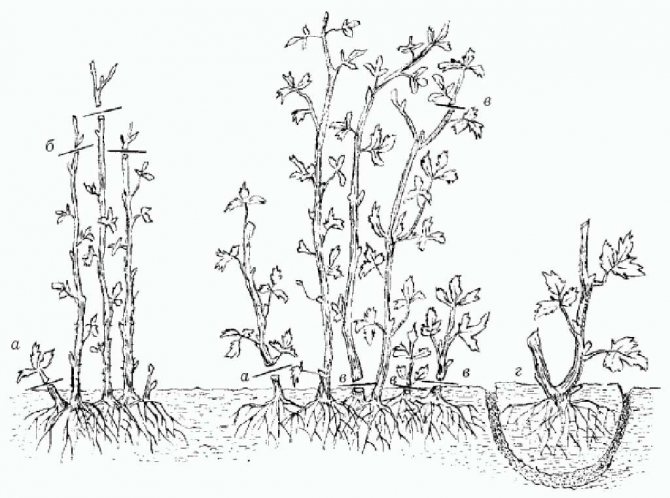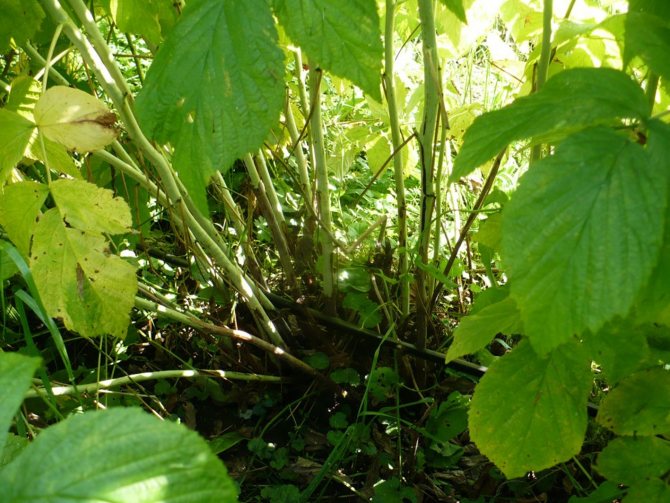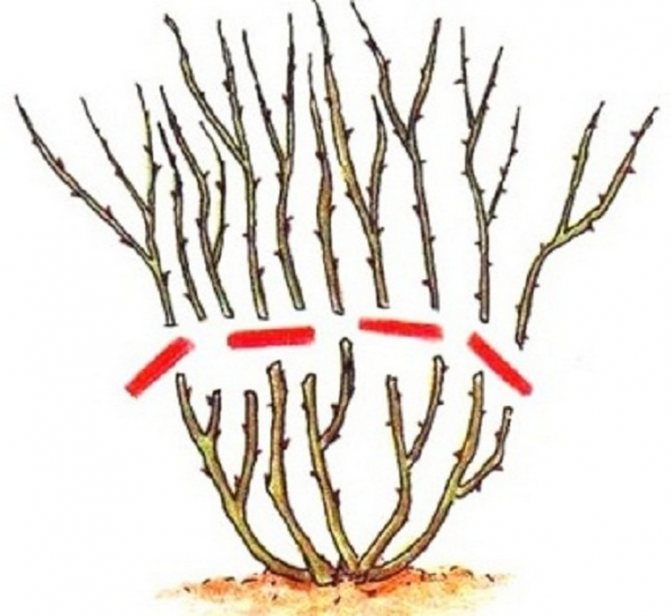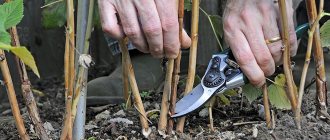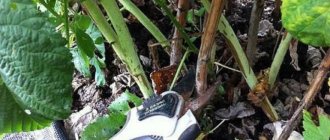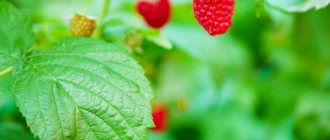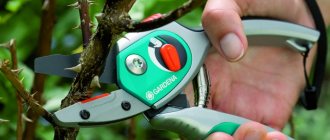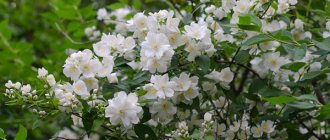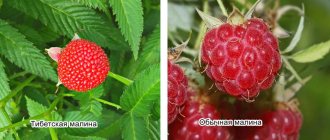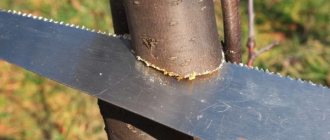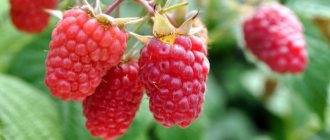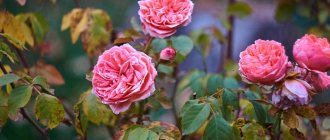Fruits and berries »Raspberry
0
244
Article rating
Correct pruning of raspberries in the fall is a guarantee of the harvest for the next season. It is carried out on time and according to certain schemes. There are several technologies that gardeners use successfully. Subsequent proper care will be the final stage so that thickets do not turn out from the fruit and berry crop.
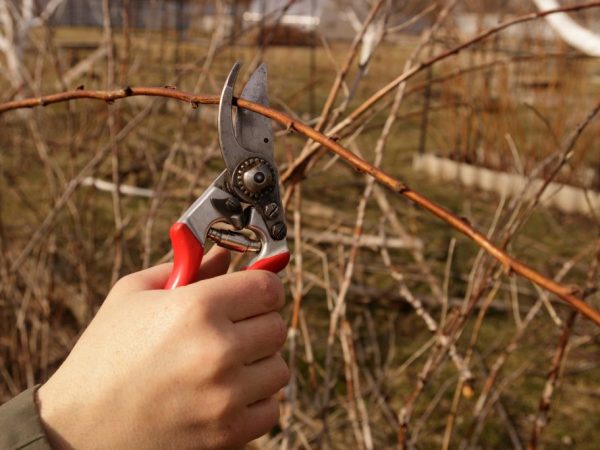
Rules for pruning raspberries in the fall - simple schemes
REPAIR RASPBERRY - GROWING AND CARE BY ALL RULES
In most regions of Russia, the most favorable time for planting remontant varieties is the last decade of September or the first days of October (just when the tulip bulbs are planted). The seedlings planted at this time have time to properly prepare for the winter cold in order to start growing in spring. Previously, planting is not worth it, because the root system of seedlings in September is not yet fully formed, which means that raspberries may not take root well.
You can also plant it in early spring by digging in the seedlings for the winter in an inclined position. Even planting in May-June is allowed, but in this case, the seedlings must be kept under a layer of snow, sprinkled with straw or sawdust, so that they do not melt longer.
In the conditions of the short Russian summer, it is better to choose new remontant varieties for growing, which are distinguished by rapid growth and early maturity.


Seedlings of remontant raspberries are planted in rows or separate bushes, like the usual one, leaving a distance of about one meter between the plants.
The procedure for planting seedlings does not differ from planting other varieties of raspberries: they dig shallow pits under the root system, add fertilizers to the soil, set the seedlings in the pits and tamp the ground. After planting, be sure to water the seedling abundantly.
Correct care:
- Due to the superficial root system, it is not recommended to loosen the ground under raspberries, and in order to avoid the appearance of weeds, the soil must be mulched;
- remontant raspberries require abundant watering during the season, especially during fruiting;
- so that the berries are large and the harvest is rich, the bushes should be fed in March with complex fertilizers, and before flowering and at the end of autumn fruiting with superphosphate and potassium sulfate;
- for the prevention of fungal diseases (powdery mildew, gray rot), it can be treated in April with Bordeaux liquid, and biological products can be used against pests during flowering.
The pruning of shoots deserves special attention, because it largely depends on how good the annual harvest of berries will be.
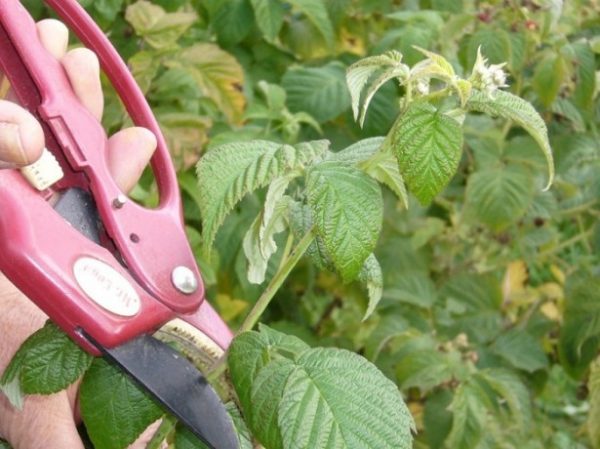

Follow-up care
After suffering stress, shrubs need to be properly cared for.
- Top dressing. Peat, vegetable compost and poultry manure-based solution are used as fertilizers. It is also allowed to use 50 g of superphosphate and 40 g of potassium sulfate per plant.
- Spraying. Treatment of common varieties is carried out with fungicides, remontant - with Bordeaux liquid.
- Watering. The rate is identical to that required for the shrub after transplanting - about 50-60 liters per berry.
- Mulching. The surface of the periosteal space is covered with a thick layer of pine needles, which prevents excessive evaporation of moisture and protects against frost.
- Shelter for the winter.The stems are tied in bunches and bent to the ground and covered with spruce branches or foliage (subject to winters with little snow). The use of polyethylene obliges to create ventilation inside the shelter, for which the material is pierced in several places.
HOW TO CUT REPAIR RASPBERRY AT DIFFERENT TIMES OF THE YEAR?
Fruiting occurs on biennial shoots, as in ordinary varieties, and on annual growth shoots. But since the plant spends too much energy on the maturation of the first harvest and on the formation of replacement shoots for the second harvest, a special technology for growing remontant raspberries is preferable.
In the first year, young shoots grow on the seedlings, which are covered with flowers in July, and berries in August. Annual shoots are not left for the next year, but all, without exception, up to three centimeter stumps are cut out. Pruning is done in October-November, when all the berries from the bushes have already been harvested.
Pruning autumn remontant raspberries not only has a positive effect on the future harvest, but also protects the bushes from parasites and viruses that usually hibernate on the shoots. In addition, even in the absence of snowdrifts in winter, hemp can be insulated, and raspberries will not freeze.
Video "How to cut remontant raspberries"
In spring, sanitizing the bushes is enough: only those shoots that have frozen or dried up over the winter are cut off for the first healthy bud. April is best suited for this procedure, since it is easier to determine which is healthy by the swelling kidneys.
Additionally, in May, you can pinch the tops of the shoots so that the fruiting of remontant raspberries begins later and is longer.
Among all the varieties of raspberries, some factories prefer exclusively remontant raspberries. There are pros and cons to growing this berry. But the pruning of remontant raspberries is especially simple, despite the fact that the crop with remontant can be harvested twice a year.
Raspberry pruning according to Sobolev
The well-known breeder Alexander Sobolev, whom his contemporaries called "Raspberry Michurin", proposed a different method of pruning raspberries: in the first year, pruning at the beginning of May, moreover, not at the base of the bush, but at a height of one meter. This activated the rapid development of both lateral shoots from the stems and the root system.
Then, with the raspberry bushes, do as usual until the next season. But in it, starting from late March - early April, each active shoot was shortened by 10-12 cm, which unusually stimulated the growth of flowers, ovaries and, in the future, fruits.
Ruthlessly remove weak, defective, underdeveloped and otherwise unviable shoots! This will allow the strong to develop normally, which will give you a magnificent harvest in the fall.
Using the Sobolev double pruning method, you need to take into account some of the nuances:
- Watering top dressing, especially in autumn, should be moderate. Overflowing water is much worse than a little water starvation.
- Considering higher yields than conventional varieties, put trellises, ladders and other structures to support the branches.
- A properly formed bush should have no more than 6 shoots.
- Young, still green, not stiff shoots, are shortened to about 25 cm.
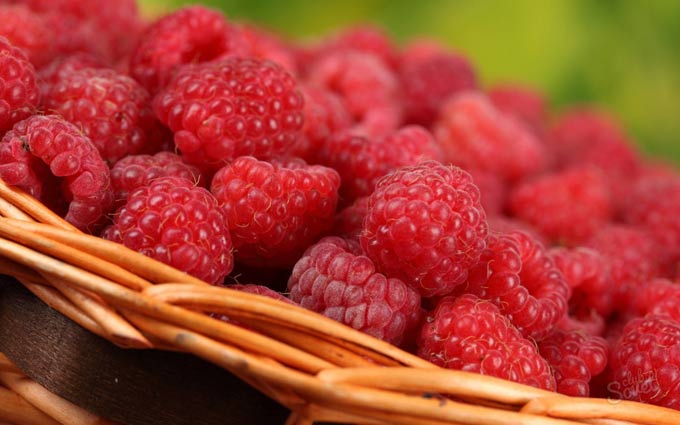

Differences in pruning remontant raspberries
There are several varieties of remontant raspberry, but all of them have three phases - growth, branching, and fruiting, which take place within one year. It is from this that the special features that distinguish pruning of this particular variety come out. So, after fruiting in all plants, the part above the ground must be completely cut off. New stems will start to appear in the spring. There will be some very weak ones among them.


Based on this, it is important to thin them out once or twice, and maybe even three times. This is so that other stems can gain strength and grow.After the next fruiting, pruning of all those that have grown during the season will again be required.
And so it turns out that remontant raspberries do not have a two-year cycle, during which growth and fruiting occurs, as in other species, but only one-year. And this gives the gardener new benefits. So dangerous diseases and pests cannot accumulate. For them, winter will not become a stage of freezing and freezing. So it is easier to look after and work much more conveniently.
Our latitudes differ not too long in summer. It is always a little lacking for maximum fruiting potential. It often happens that only having managed to collect the very first berries, many flowers and ovaries still remain on the branches, the first cold weather is coming.
Pruning can be carried out in another way. So some gardeners carry out this procedure, as when growing conventional varieties. Although the stem has already borne fruit, it will still not dry out. Raspberries overwinter, and again they will branch, again give berries. During fruiting, new stems and berries will have time to grow.


The repaired variety gives two harvests per season. Even if they cannot yield more harvest than ordinary varieties, the time for harvesting and consuming fresh raspberries will become longer. And the coming autumn will bring additional harvest from these stems.
With this method, it is important to remove the two-year-old stems almost immediately after harvesting in mid-summer. You also need to carefully normalize the newly growing stems.
Gardeners should remember not to double prune raspberries if you have a remontant variety. The reason is that in the Middle Lane one part of the crop does not have time to ripen at all. If, at the same time, pruning is carried out, the gardener will spend extra time so that side shoots are formed. Because of this, it may be delayed.
The very first crop has time to ripen on the overwintered shoots. The second crop grows on annuals. To speed up the process, you need to cut off last year's victories. After harvesting, as well as pruning, you need to feed the bush. In September, pruning of remontant raspberries on fresh shoots is to be done.
Purpose of the procedure
For ordinary varieties, the appearance of fruits is characteristic only on 2-year-old shoots, annuals are covered exclusively with foliage. A year later, the yield drops significantly, so the main task is to eliminate unproductive branches.
As a result of pruning, young shoots receive the necessary nutrients and light, which allows them to moderately grow stronger before winter and tolerate temperature fluctuations without losses.
Additionally, the risk of damage by harmful insects that have settled on dead shoots is reduced. The preservation of young shoots in large numbers is also fraught with the wilderness of the culture.
Autumn raspberry pruning is intended for:
- increasing yields;
- preventing the spread of bushes due to the rapid development of root growth;
- normalization of aeration and illumination of the inner part of the crown - crowding is an excellent condition for the vital activity of pests;
- providing easier harvesting.
Pruning time
Gardeners often ask themselves different questions. For example, how to prune remontant raspberries in the fall. It doesn't matter if this procedure is carried out in the fall or spring, no one doubts the importance of keeping the pruning time. The very terms depend on the pruning option: for growing for two crops and for growing for 1 crop.
If you need berries right away in summer and autumn, for which a remontant variety is great, pruning should be carried out both in late autumn and early spring. Remember that pruning of remontant raspberries in this case is not carried out on the entire shoot, but on where the berries were.
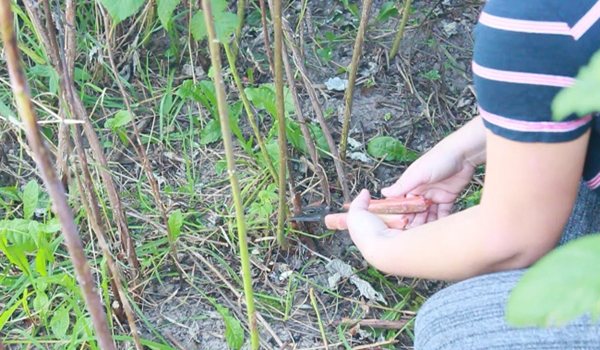

In this case, one part of the shoot will remain, with which a wonderful summer harvest will be formed.And the autumn harvest will reach on the grown one-year fresh shoots.
Another variation is growing raspberries per crop. With this option, the remontant variety is cut in November. Old shoots and those that have already managed to bear fruit are cut right to the level of the soil. Why? Otherwise, the ones that remain will give rise to new shoots, which will create a two-year cycle for the raspberries. This means that all the work done will go to waste. Freshly cut branches must be burned. The rhizome itself remains to survive the coming winter, where there will also be dormant buds. They will grow in early spring.
Pruning running raspberries
Is it possible to extend the vegetative period of a raspberry tree without destroying the old one that has been harvesting for more than 10-15 years? Partial rejuvenation, carried out on warm September days or in spring, will give results. To do this, proceed as follows:
- Choose old, low-yielding bushes and remove them along with the root.
- A shovel is made around the bush in order to cut off all the roots, after which the root is carefully removed. The work is carried out so as not to damage the root suckers located far from the main old root.
- Empty pits after the root are covered with compost or nutritious humus. A year later, full-fledged shoots will grow on new rhizomes.
The procedure for removing old roots is repeated 3-4 years in a row, gradually removing all old fertile bushes from the site.
Pruning technique
Raspberries of this variety bear fruit on the shoots of two years ago, just like the varieties familiar to gardeners. But also on the shoots of the same year, which have the form of increments. But the plant is spending too much energy to ripen the first crop, as well as to further form shoots to replace and grow the second crop. Therefore, pruning remontant raspberries has its own technique.
In the first year of growth, very young shoots begin to grow on the seedlings. In July they will be covered with flowers, and berries - in August. Next year, those same annual shoots cannot be left, they should all be cut out to hemp 3 centimeters in size. Such pruning is carried out in October and November, at a time when all the berries have already been harvested from the bushes.
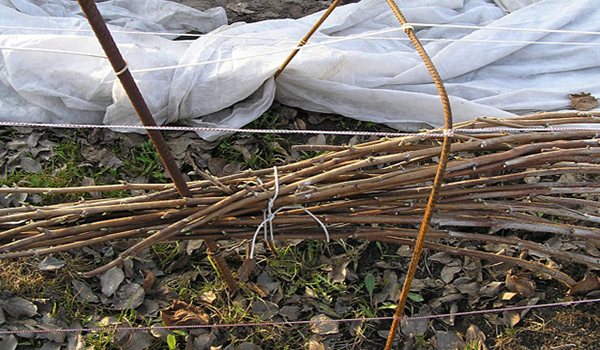

For remontant raspberries, autumn is the time of pruning, which will have a positive effect not only on the future harvest. This procedure will protect berry bushes from viruses and parasites, which usually hibernate on the shoots. Even if there are no snowdrifts in winter, hemp can be insulated, in this case the raspberries will not freeze.
In the spring, the gardeners plan to sanitize all the bushes. For the first healthy bud, you only need to cut off those shoots that have managed to freeze and dry out over the winter. The last month of spring is most suitable for this procedure. Why? Yes, just then the swelling kidneys will already be visible, thanks to which it will be easier to identify healthy and unhealthy ones. As an additional measure, you can pinch the individual tops of the shoots. This will make the fruiting of the remontant variety longer. So it will start later.


By paying sufficient attention to pruning and caring for remontant raspberries, the grower will get excellent results in the form of a harvest of fresh, beautiful berries. After all, what could be better than fresh berries?
General recommendations
When pruning raspberry bushes, you must adhere to certain rules:
- The arrangement of the branches is planned like a fan in order to avoid excessive foliage and thickening.
- All two-year-old shoots are cut at the root immediately after harvest.
- They remove damaged and deformed shoots, pulling the forces of the plant towards themselves, not allowing the berries to grow fully.
- In specimens growing in regions with a harsh climate, young shoots are removed, which are not able to stiffen by winter.
- The parts formed in the summer due to their insufficient strength are cut down.
Additionally, it is required to determine the optimal crop height. This can be done based on the following scheme:
- Weak tops are shortened to the first healthy kidney.
- The branches are cut in full by 25 cm.
- In young processes, the tops are trimmed, leaving a length of 1.2-1.5 m.In the case of a weakened state, their size is allowed to be reduced to 1 m.
Video “Pruning for the winter. Raspberry care rules "
The video shows the rules and tips for pruning raspberries. What mistakes should not be made, how best to prepare the bush for wintering.
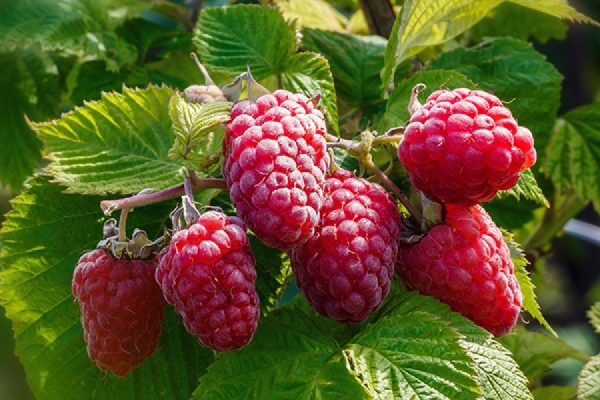

Gardening raspberries are very popular with gardeners due to the rich harvests that it gives twice a year and the ease of caring for them. This is rare with ordinary varieties. But pruning remontant raspberries must be done at a certain time and correctly, so that the further harvest is good. Having done this work correctly, ensuring soil moisture and feeding it, you can count on the fact that raspberries will give a good harvest in the fall.
Tools for cutting raspberries in autumn
Even before starting the procedure, you must prepare and sharpen the necessary tools. What we need to work with:
- Sicator. It must be well-perfected. Instead, you can use the scissors designed for key bush.
- Saddle knife. It is used in difficult cases, when the stems are cut unevenly.
- Succopez. He can sit on thick stems.
- Rakes. They will find an application when you need to remove the cut branches and moldings from the raspberry area.
Remember! Raspberry of ordinary copts is not able to form the harvest of berries on the run of the current year, flower buds can be produced only on two-year-olds.
Repair raspberry: what is it?
This variety of raspberries attracts the attention of gardeners because two crops can be harvested in one year. The first one can be removed already from annual shoots at the end of summer, and the second one falls on autumn. But many answer that the quality of the second harvest is not always as high as that of the first, and besides, if you take off the summer harvest, you can wait a long time for the autumn one. The berries themselves, according to reviews, are dry and juicy. This is due to the fact that raspberries give most of their strength to the formation and ripening of the first, summer, harvest, so the plant simply does not have enough strength for autumn fruits.
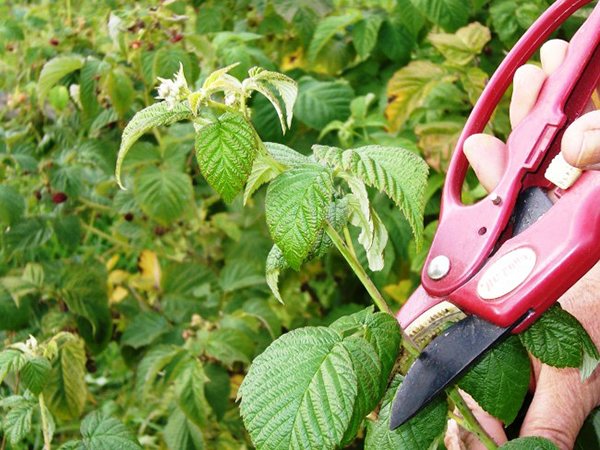

Because of this, gardeners prefer to grow remontant raspberries as one year old, since in this case the harvest is good. This variety is good because there are no problems with its cultivation, it is enough just to properly cover it for the winter and cut off the dried branches in a timely manner. The resistance of a plant to the effects of fungi, viruses, diseases is an important factor that attracts the attention of gardeners, especially beginners. Pruning remontant raspberries in the fall (video) is a simple process, a beginner can also handle it, which speaks in favor of planting this particular variety.
Description of raspberries
Raspberry belongs to the Rosaceae family. Homeland - Central Europe, Asia, America.
Raspberry refers to a plant whose berries have been used by people since time immemorial. Its seeds were repeatedly discovered by archaeologists during excavations of human sites dating back to the Stone and Bronze Age. Wild raspberries are very widespread in Europe and Asia. It was first described by the Roman scholar Pliny the Elder (1st century AD). Later, the botanist Karl Linnaeus (18th century) gave the name to the raspberry proper.
Despite the early acquaintance of people with raspberries, data on its cultivation date back to a later time. So, raspberries with red and white fruits began to be cultivated in Germany and England from the 16th century, in Russia - from the 17th century, in America - from the end of the 18th century. More accurate information about raspberry varieties dates back to the 19th century.
The whole variety of cultivars of raspberry comes from the following three species: red raspberry, which includes two distinct subspecies - European red raspberry and American bristly; black, or blackberry, raspberry and purple raspberry, which is an interspecific hybrid from the spontaneous crossing of black blackberry and American bristly raspberry.
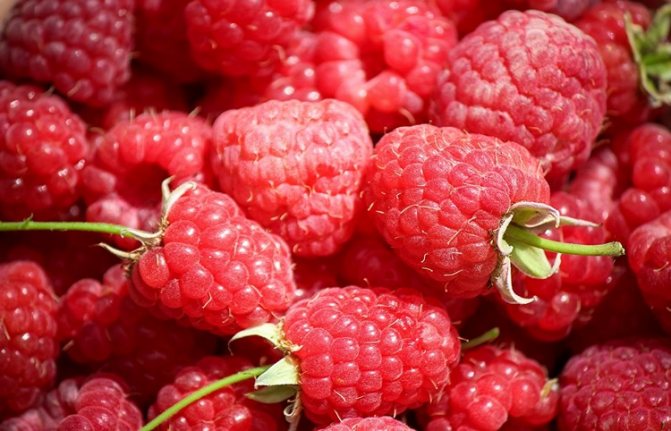

Keeping track of deadlines
In the climatic conditions of our country, it is recommended to plant this variety of raspberries in the last decade of September or in early October.Planting in this time period ensures the preparation of plants for cold weather, and in spring they begin to grow in time. Before this period, planting is not worth it - experts say that by September the root system of the plant will not yet be developed, so raspberries may not take root well. Repaired varieties are popular due to the fact that in the climatic conditions of Russia they grow better, and the fruits themselves are ripe and tasty.
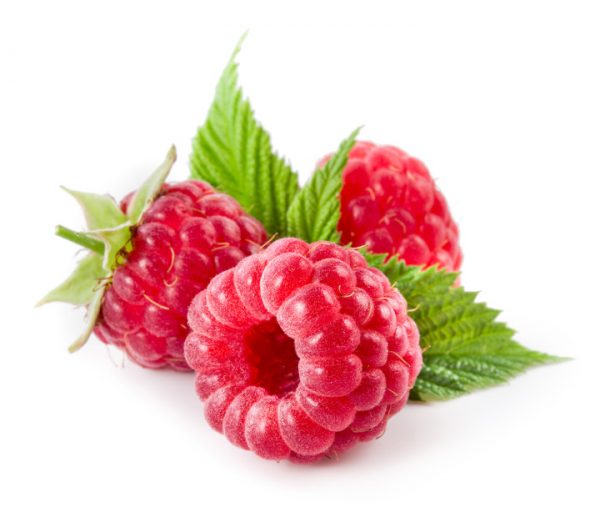

Planting is possible both in spring and summer, but in this case, the seedlings must lie under a layer of sawdust, straw, snow, so that the roots are intact. Planting is carried out either in a row or separately by bushes, the distance between seedlings should be at least one meter. For planting, shallow pits are dug under the roots, the soil is treated with fertilizers, the seedlings are planted, after which the earth is rammed.
Cropping correctly


The peculiarity of the root system of this plant is that it is located on the surface. And this requires a more attentive attitude to the soil. You can get rid of weeds by mulching the soil. The second important point is the abundance of watering of raspberries, and watering must be monitored all the time while the bush bears fruit. To please the berries and the harvest with size and wealth, it is advised to fertilize raspberries in a timely manner with complex fertilizers. The optimal time for this is March, and for this use popular superphosphates or potassium sulfate. To prevent the appearance of fungal diseases, you can treat the bushes with Bordeaux liquid.
Pruning features
Raspberries begin to bear fruit when the shoots are about two years old. Someone harvests one crop, someone - two. But there is one "but": when the first harvest is formed and ripens, the plant spends too much energy on these processes, so they are not enough for the second harvest, which affects the taste of berries and yield. That is why you need a special technology for remontant raspberries. During the first year of life, the seedlings are gradually overgrown with young shoots, which bloom in July and bear the first fruits in August.


Annual shoots should not be left for next year, so experts advise cutting them out to a size of 3 cm. Pruning of remontant pruning is performed from October to November, when there are no longer any berries on the bushes. Such a decision must be made in a timely manner - this will not only have a positive effect on the future harvest, but also allow protecting the bushes from viruses, fungi, which may well overwinter on the shoots.
When is it time?
Gardeners love remontant raspberries. Pruning in the fall, in their opinion, should be performed when the shoots reach two years of age. When finishing the bushes, all the stems that have given a good harvest of berries are cut off at the base, it is important to remove weak young roots. If you are breeding this variety of raspberries, then total pruning will be required, that is, the removal of all roots.


This is useful as it can protect the bushes from numerous pests and diseases. Autumn for pruning is not chosen by chance - it is at this time that the leaves begin to wither, there is no frost yet, and there are no nutrients coming to the roots either. If you do not cut the bushes to the base and leave some of the shoots, then the new bushes will grow low in growth, and the raspberries will lose their remontability, that is, the ability to re-flowering and fruiting.
What are the features?
Pruning raspberries in remontant autumn should be done correctly - this is a guarantee that the bushes will not yield a lower yield. Any varieties of remontant raspberries develop in three faces - growth, branching, and then fruiting, and all these stages take place within one year. Therefore, raspberries need to be thinned at least two or three times a year - this will allow the stems to gain strength and grow actively. It turns out that in fact this variety of raspberries blooms and bears fruit once a year, which has its own advantages.First, dangerous diseases do not accumulate. Secondly, the stems will not freeze and freeze in winter.
Video “Repaired raspberry. Features of care "
The most basic rule is to timely take care of the remontant raspberries in autumn and timely pruning (the video shows that this process is simple, and everyone can handle it). Stems that are already two years old must be removed after harvest, and the growing stems must be under control. But double pruning is not needed when growing a remontant variety, since in the conditions of the Middle Lane it simply does not have time to ripen a second time. And if you cut them off, it turns out that it will take more time for the formation of lateral shoots, and the fruiting itself will be postponed.
Features of remontant varieties of raspberries
Raspberries are an unusually tasty berry that has a number of medicinal properties. It strengthens the immune system, helps cure colds, relieves fever and even renews blood.
Remaining raspberry varieties began to gain more and more popularity. They liked gardeners very much, as they give a large harvest and are rather picky about care.
Features of remontant varieties are as follows:
- They bear fruit 2 times a year. Summer harvest ripens on the branches of the first year, and spring - on the stems of the second year of life.
- Most of the harvest can be harvested in the fall. Fruiting begins in August and ends only in late autumn.
- The remontant raspberry differs from ordinary varieties of berries in that it hangs on the branches for a long time, while it does not crumble or rot.
- With proper care, the bush is practically immune to various plant diseases and insects.
- If you prune remontant raspberries in the fall, then the root system should not be covered.
- Gives very few offspring, and even replacement shoots.
On average, up to 5-10 kg of berries can be harvested from one raspberry bush. This is a very good indicator. The weight of one fruit reaches 8-15 g, they have a good density, yellow or red color and an incomparable taste.


In total, 20 varieties of remontant raspberries are registered in Russia. They all have different ripening periods. The best varieties include:
- Yellow Giant (suitable for growing in central Russia);
- Bryansk Divo (the most drought-resistant and heat-resistant variety);
- Indian summer (it is better to plant in the central and southern part of the country);
- Ruby necklace (refers to mid-season varieties);
- Polka (the most fruitful type of raspberry).
You may be interested in: Pruning roses for the winter: rules and recommendations
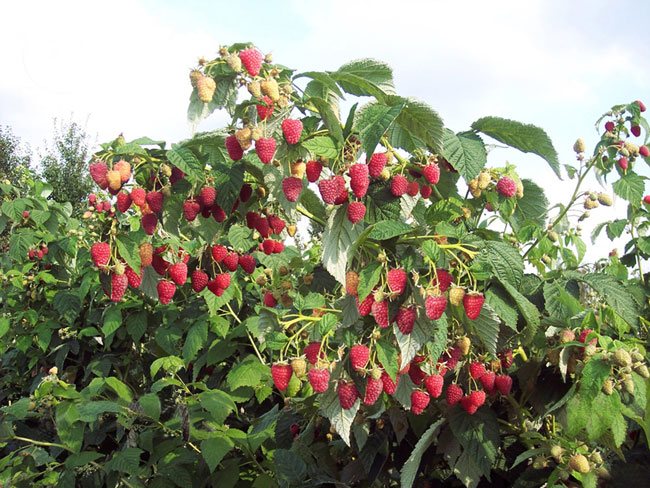

When to trim?
Pruning remontant raspberries for the winter is always carried out in the fall, but the duration of this procedure depends on how many crops you want to get per year - two or one. If you plan to harvest both in the summer and already in the fall, and remontant raspberries provide such an opportunity, then pruning is carried out either late in the fall or in early spring. But here it is important to follow the rule - pruning is performed on those shoots that were with berries. That is, some of the remaining shoots will give a good harvest in the summer, and in the fall the berries will ripen already on the regrown pruned shoots.


If you are counting on one harvest, then the remontant raspberry pruning is performed in the fall (video), in November. The technique is as follows: the shoots are cut almost to the level of the soil, and both old branches and those that have already yielded are cut off. This method will prevent the emergence of new shoots.
Rules and procedure algorithm
In order for raspberry pruning to be successful in the fall, a few simple rules should be followed:
- Weak, broken, diseased and damaged shoots, as well as fertile flowers should be removed;
- It is important to cut off young shoots that cannot survive the winter;
- Fruiting stems at the age of two years and older should be cut off so that they do not interfere with the rest of the plant's fruit.
When pruning, old branches that have borne fruit, as well as damaged, diseased and weakened parts of the plant, are always removed. The stems are shortened almost to the level of the soil, leaving the length of the stem no more than 5 cm from the ground. Diseases and pests can settle in higher stumps. Old and dry shoots break out easily, even without the help of a pruner, but it's still worth stocking up on this pruning tool. Diseased shoots are pruned so as to completely remove the affected area. In this case, it is advisable to leave at least 40-60 cm of the stem.
If black spots are visible on the bushes, then it is advisable to uproot such plants. However, if the affected area is small, then it is enough to cut off the branches with spots at the very root. On each bush, 5 - 6 of the most promising shoots are left on the bush. The tops of annual shoots are shortened by 20 - 30 cm so that they do not slow down the ripening of fruits in other branches.
Raspberries, which have been sick throughout the season, must be treated in the spring with various fungicides and insecticides.
Required inventory
Properly selected inventory plays an important role in pruning. First of all, you need to find a secateurs. It must be clean, sharp and intact. Before pruning, it is washed, cleaned, lubricated and sharpened.
In addition to the secateurs, gloves are required. It is better to put on a canvas mitten on the left hand. It is not necessary to wear something on the right one.
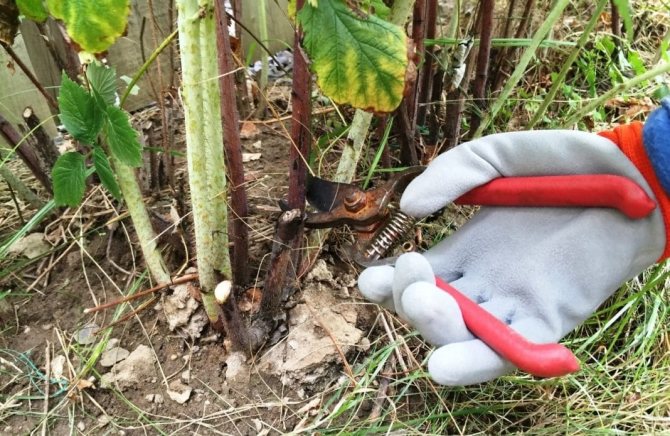

To trim raspberries in the fall, inventory will be needed
In addition, before trimming, you should stock up on comfortable clothes that you will not be sorry to get dirty and even throw away. A tight overalls are best. Shoes should be such that the pants can be tucked into them. This clothing will protect you from injuries and insects while moving around the raspberry tree.
Pruning technique
In many ways, the procedure depends on how densely the bushes have grown. If there is no passage between them, then you will have to cut the plants in layers. If the passage between the bushes remains, then it will be easier to cut. It will be necessary to wade between the bushes, removing old shoots. Last year's shoots are brown, woody and almost dry.
During the procedure, one-year young shoots are removed, weak, diseased and damaged stems, the overgrown raspberry tree is thinned out, it is worth leaving no more than 10 stems on the bush. Cut off shoots are immediately burned, as dangerous insects could settle in them. After pruning, the bushes are dug in to get rid of weeds, which can also take useful nutrients from plants. Shoots growing at ground level should also be pruned. Freshly cut bushes should be fed and treated with copper sulfate to protect them from pests and accelerate growth.
Another interesting option is to double prune the raspberry tree. But this requires skill and accuracy so as not to ruin the entire landing. In this case, the plants are initially planted with a supply of mineral and organic fertilizers. The first pruning is done at the end of May. Then, at meter-long branches, the top is pinched to a height of 15 cm. As a result, lateral shoots grow more actively, reaching half a meter in length by the end of summer.


Raspberry pruning technique in the fall
It is very important to start pruning on time, otherwise the berries will not have time to ripen, and the plant will endure the winter worse. In the second year, with the appearance of leaves, a second pruning is carried out. The overwintered branches are pinched again by 15 cm. So new buds will wake up, giving shoots that bear fruit in the future. Double pruning increases the number of ovaries on the bush and significantly increases the yield.
Pruning technique
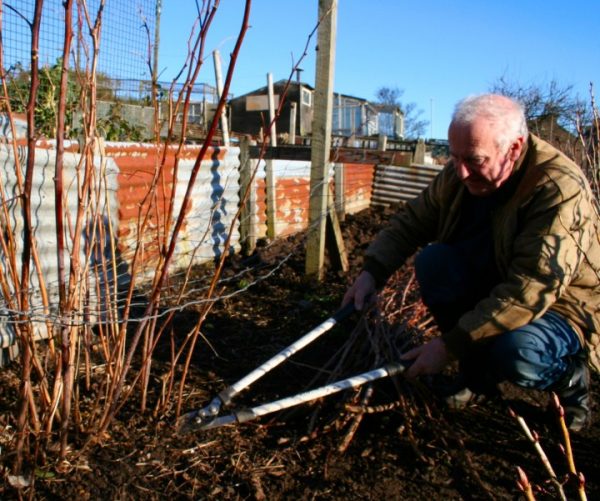

Pruning remontant raspberries for the winter is a responsible process, since a number of features must be taken into account. The stages of this work are as follows:
- first, you need to cut young and old shoots: raspberry bushes must be carefully removed from dried branches that have already given fruit in this years, and pruning is performed at the root - this will prevent infection of plants with infections and protect against insects that can get inside;
- it is necessary to get rid of young shoots, it makes no sense to leave them, moreover, it is important for us to leave strong new trunks, shortened to 20-30 cm;
- the trunks are chopped off: so that the raspberries do not grow too much, the trunks are chopped off. Experts say that the distance between them should be at least 60 cm - in this case, the bushes will grow comfortably;
- leaves are removed: caring for remontant raspberries in the fall, pruning suggest attention and care for the leaves. They must not be torn off so as not to harm the buds and not to disturb the correct growth of the plant. You can get rid of the leaves by running your gloved hand along the trunk: all the old leaves will fall off by themselves. Leaving the leaves is not recommended, as they will begin to rot, and this will lead to the death of the buds;
- raspberry bushes bend down: after all old leaves have been removed from them, the bushes need to be bent to the ground. This is done to protect the top of the trees from frost. You can fix them with wire.
Why prune raspberries in summer and fall
Due to the tendency of raspberries to grow, it is necessary to limit the growth of excess root growth so that it does not take away the vitality of the mother plant. Numerous shoots that have appeared at a distance of more than 0.2–0.3 m from the bush must be cut down mercilessly. This is done regularly, the thickening of the plantings should be monitored throughout the growing season.
You don't even have to remove the sprout itself, but simply stick a shovel into the ground next to it at a slight angle to cut the root feeding it. Experienced gardeners advise to immediately outline a certain number of strong stems (10-14 pieces), which will bear fruit next year, and periodically destroy the rest of the unnecessary shoots.


Excess young growth of raspberries must be cut
The raspberry tree needs to be constantly inspected and promptly removed yellowing foliage, diseased shoots and all suspicious branches. The removed elements must be burned to stop the development of infection and protect the rest of the plantings.


Leave only the required number of shoots, the rest are removed
Raspberry growths have to be removed several times over the summer. It is easier to do this with a small, sharp metal spatula. When sticking it into the ground, the feeding root is simultaneously chopped off and the shoot is undermined. If you bypass the planting about once a week and remove unnecessary young growth, then this process takes very little time.
This culture is very prone to overgrowth, therefore, in the summer, the growth of excess growth should be limited (so that it does not have time to take root). If you see numerous shoots sticking out of the ground within a radius of 20-30 cm from the base of the bush, remove them decisively. In this case, you should, as it were, chop the root system of the shoot with a shovel.
Pruning raspberries in the summer after harvesting is a mandatory procedure in which all branches that have fruited are removed. When they are cut, even insignificant stumps should not remain, which can later become a refuge for parasites or pathogens. The sooner the cleaning of its spent shoots is carried out, the more vitality will get to the young branches with fruit buds.
Secrets of Proper Preparation
For all plants, preparation for winter plays an important role, since if they are under the snow, they most likely will not bloom and bear fruit when it should be. Raspberries are a very moody plant that needs to be closely monitored.So, many do not pay due attention to bending the bushes when preparing them for winter, but this must be done: if the stems remain on the ground, then there is every chance that they will freeze. It is important that in winter the stems are constantly covered with snow, which will provide reliable protection for plants and good fruiting.
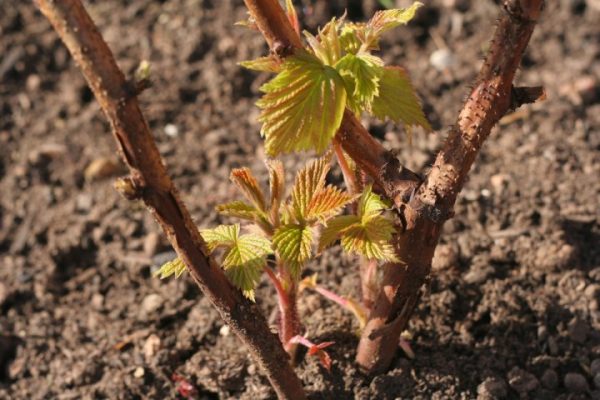

Caring for remontant raspberries in the fall, pruning it must be done correctly, since the condition of the plants depends on whether they can overwinter. So, overfed with nitrogen leads to the fact that the bushes become less resistant to cold weather. Plants that were in the shade during flowering and fruiting will not be distinguished by their resistance - most likely, they will not survive the winter well. If suddenly there is not enough snow, then the raspberries must be constantly covered with them.
Further care and preparation for winter
In the fall, thin, recently appeared shoots are also cut out from the ground. They do not have time to gain the necessary growth force before the onset of winter, so green shoots will not survive in the frosty period, and in the fall they will only lengthen the life force of the bush. The stems remaining after pruning, as well as fallen leaves and other waste, are taken outside the garden, and then burned.
Read on to learn how to prepare raspberries for wintering.
In the south, raspberries are most often grown that are not afraid of a little frost, so the bushes are not insulated before the arrival of winter. In colder and more northern regions, raspberry shoots are pressed to the ground and fixed to its surface with long metal pins. Such preparation will protect the shoots from freezing and mechanical damage under the weight of wet snow.
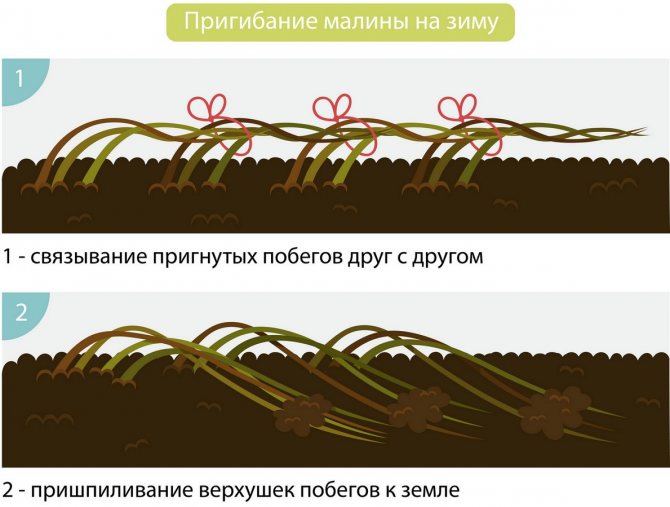

After heavy snowfalls, raspberries pinned to the soil and the space within a radius of 1.5 m from the roots is additionally covered with a snowdrift. The snow will protect the roots of plants that are shallow in the ground from the effects of frost. As the experience of gardeners has shown, this is a good protection of plantings from low subzero temperatures.
Thanks to the correct autumn pruning of the raspberry tree, the plants will have time to get stronger before the onset of the winter period and lay fruit buds for the next year. With the arrival of spring, such plants quickly enter the growing season, bud and begin to bloom.
Fighting sprawl
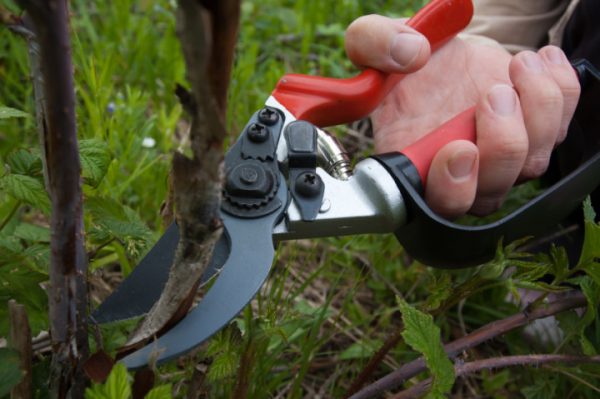

Pruning remontant raspberries in the fall may seem like a daunting process for novice gardeners. But in reality, there is nothing complicated about it. It is much more important to properly prepare the bushes for further operations. One of the problems that arise when caring for raspberries is the overgrowth of bushes. Due to the special structure of the root system, the plant constantly creeps in different directions, and simply tying up the bushes is not enough. This problem is especially serious for those who keep entire plantations of raspberries - in this case, the growing branches can easily fill the aisles. To avoid this, young shoots must be constantly removed - they interfere with the growth of fruiting bushes and take nutrients from the soil. A good way to deal with young growth is to use a barrier in the form of sheets of slate or metal.
Mistakes of novice gardeners
When pruning, beginners make a number of mistakes that can affect not only the abundance of the crop, but also the health of the raspberry tree:
- They begin pruning from the outer branches, cutting out young shoots, but do not look deep into the raspberry tree. This leads to a thickening of the planting, which can make the plants sore.
- Do not remove intertwined or end-to-end shoots. Such branches are deprived of the protective layer on the surface, are injured, which is fraught with the invasion of pests and the development of diseases.
- Old branches are not cut at the root, leaving hemp. Open shrub tissues are a fertile environment for infections and parasites.
- Only old branches are removed. The bush must be thinned and shaped so that the strongest and healthiest shoots receive enough nutrients, sunlight and air to form large fruits.
- Damage to the kidneys due to the wrong scheme of the procedure. Therefore, first remove large shoots, then those that are smaller.
If you follow these rules, then next summer the raspberry will delight its caring owners with large, tasty berries.


5 / 5 ( 1 voice)
We mulch the soil in a timely manner
Raspberry is a plant with a special root system: it is located literally at a depth of 15 cm from the surface of the earth. Therefore, the roots can freeze in winter and dry out in summer. Because of this, it is imperative to mulch the soil - this will provide an optimal balance of temperature and moisture for the roots. In addition, the soil will not form a crust, and the roots will always have enough oxygen. Mulching is carried out immediately after the raspberries are planted, you need to mulch to a depth of 7 cm. In mid-September, to nourish the plants, you can scatter mineral fertilizers based on phosphorus and potassium between the rows, which are embedded in the soil along with the mulching layer.
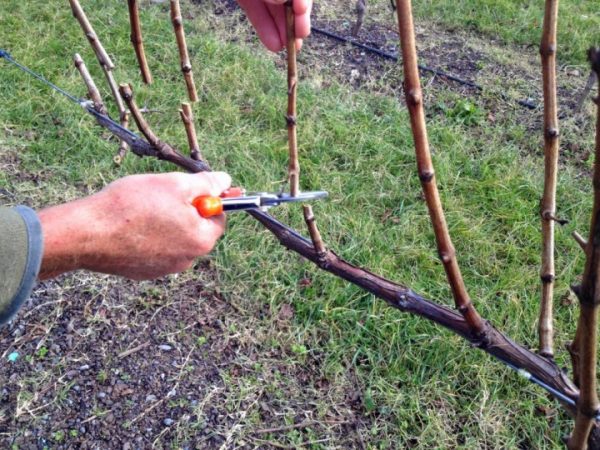

In the spring, nitrogen fertilizers are already introduced into the soil, and the soil is again covered with a mulching layer. Such a decision will lead to the fact that every year, when mulching, the layer will be more and more fertile, and there will be a lot of humus in it. Raspberry care will be easier as less growth will form and there will be almost no weeds left. The mulching layer is created on the basis of humus, straw with the addition of chopped bark, sawdust and needles.
Caring for bushes after pruning
Any pruning is stressful for the plant, and raspberries are no exception. Therefore, after the procedure, it should be fed:
- in summer, sprinkle ash or bone meal under the bushes;


After pruning, raspberry bushes need potassium, which is abundant in wood ash.
- sow green manure in the fall, followed by cutting and burying it in the soil around the bushes;
- every few years in the fall, add manure or compost.
To prevent damage to the bush by pests, immediately after the procedure, raspberries are treated with Decis, Fufanon-Nova according to the instructions. Bordeaux liquid will help from diseases (after the leaves fall, the raspberry is sprayed with a 3% solution).
Watering raspberries after summer pruning is necessary as usual, but after autumn, abundant watering is necessary (4 buckets per bush). It is especially relevant in the southern arid regions, since wet soil freezes more slowly than dry soil.
In the fall, before wintering, it is necessary to change the mulch to fresh: larvae of pests and fungal spores may remain in the old one.
conclusions
Many gardeners are hesitant to prune raspberries before wintering. Experts say - definitely worth it. As we understood from the article, this will not only increase the chances of a good harvest by summer and autumn, but also protect the bushes themselves from various harmful factors - diseases and fungi. In addition, due to high-quality and timely pruning of raspberries, they will grow in more comfortable conditions, and you will avoid overgrowth of thickets that can stretch throughout the garden.


Benefits of Autumn Pruning
To grow a healthy bush and get the maximum yield, you should regularly perform the pruning procedure, or as it is also called, thinning.
For novice gardeners, it is not clear what this procedure is for.
There are three thinning options and each has its own function:
- Spring thinning - carried out as soon as the snow melts.
- Summer thinning - immediately after fruiting.
- Autumn thinning - approximately 3-4 weeks before the onset of cold weather.
Ideally, all three options should be completed in one calendar year. However, autumn events are the most important, so we focus on them.
Correct pruning in the fall brings the following results:
- Immunity is noticeably improved, which helps to survive the winter. Bushes that have undergone thinning freeze out much less often.
- Preventive actions.The reproduction of harmful insects is prevented, and fungal diseases are stopped.
- After thinning, the plants begin to ventilate better and also receive more sunlight. Thanks to this, the likelihood of a fungal disease is reduced.
- The appearance is improved.
- Easy access to berries during ripening.
Any preparation for the winter of a shrub should not be complete without thinning. It will not only significantly improve the yield, but also strengthen the plant, and this leads to a long and fruitful life.
For the season, the average bush gives up to 20 young shoots. After the fall pruning, half should remain. The rest is mercilessly cut off, as it will interfere with the normal development of the rest.

